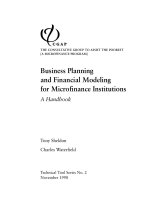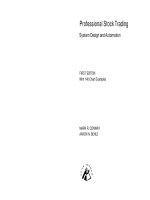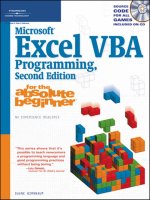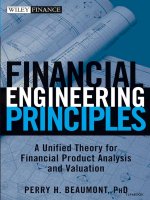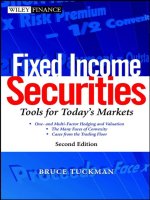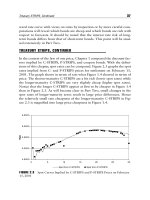Study guide for come into my trading room phần 1 ppsx
Bạn đang xem bản rút gọn của tài liệu. Xem và tải ngay bản đầy đủ của tài liệu tại đây (177.75 KB, 17 trang )
STUDY GUIDE
FOR
COME INTO MY TRADING ROOM
Dr. Alexander Elder
www.elder.com
John Wiley & Sons, Inc.
New York
•
Chichester
•
Weinheim
•
Brisbane
•
Singapore
•
Toronto
STUDY GUIDE
FOR
COME INTO MY TRADING ROOM
BOOKS BY DR. ALEXANDER ELDER
Trading for a Living
Study Guide for Trading for a Living
Rubles to Dollars:
Making Money on Russia’s Exploding Financial Frontier
STUDY GUIDE
FOR
COME INTO MY TRADING ROOM
Dr. Alexander Elder
www.elder.com
John Wiley & Sons, Inc.
New York
•
Chichester
•
Weinheim
•
Brisbane
•
Singapore
•
Toronto
Copyright © 2002 by Dr. Alexander Elder. All rights reserved.
Published by John Wiley & Sons, Inc.
No part of this publication may be reproduced, stored in a retrieval system or trans-
mitted in any form or by any means, electronic, mechanical, photocopying, recording,
scanning or otherwise, except as permitted under Sections 107 or 108 of the 1976
United States Copyright Act, without either the prior written permission of the
Publisher, or authorization through payment of the appropriate per-copy fee to the
Copyright Clearance Center, 222 Rosewood Drive, Danvers, MA 01923, (978) 750-8400,
fax (978) 750-4744. Requests to the Publisher for permission should be addressed to
the Permissions Department, John Wiley & Sons, Inc., 605 Third Avenue, New York,
NY 10158-0012, (212) 850-6011, fax (212) 850-6008, E-Mail:
This publication is designed to provide accurate and authoritative information in regard
to the subject matter covered. It is sold with the understanding that the publisher is not
engaged in rendering professional services. If professional advice or other expert assis-
tance is required, the services of a competent professional person should be sought.
This title is also available in print as ISBN 0-471-22540-1. Some content that appears in
the print version of this book may not be available in this electronic edition.
For more information about Wiley products, visit our web site at www.Wiley.com.
CONTENTS
Study Guide for Come Into My Trading Room 1
How This Book is Organized 3
Part One Questions 5
1 Financial Trading for Babes in the Woods 7
Questions 1–8
2 Mind—The Disciplined Trader 13
Questions 9–18
3 Basic Charting 21
Questions 19–23
4 Indicators—Five Bullets to a Clip 27
Questions 24–39
5 Trading 39
Questions 40–47
6 Day-Trading 47
Questions 48–53
7 Advanced Concepts 53
Questions 54–67
8 Money Management 63
Questions 68–82
9 The Organized Trader 71
Questions 83–100
v
Part Two Answers and Rating Scales 83
1 Financial Trading for Babes in the Woods 85
Answers 1–8
2 Mind—The Disciplined Trader 91
Answers 9–18
3 Basic Charting 97
Answers 19–23
4 Indicators—Five Bullets to a Clip 101
Answers 24–39
5 Trading 111
Answers 40–47
6 Day-Trading 115
Answers 48–53
7 Advanced Concepts 119
Answers 54–67
8 Money Management 127
Answers 68–82
9 The Organized Trader 133
Answers 83–100
Part Three Let’s Trade: Case Studies and Questions 141
Part Four Let’s Trade: Answers and Ratings 163
The Road Ahead 197
Sources 199
About the Author 201
vi CONTENTS
We conclude the Study Guide with a chapter called The Organized
Trader. A person who is serious about his success has to organize his
decision-making process and record-keeping. Questions in this chapter
deal with trading records such as the equity curve, trading spreadsheet,
and trader’s diary. They cover time management, setting priorities, and
rating your performance.
The charts in the Study Guide go beyond illustrating key analytic
points. Each comes with questions about what you would do at the right
edge. Signals tend to be clearly visible in the middle of the chart, but
grow foggy as you get closer to the hard right edge. That’s where you
have to make trading decisions, in the atmosphere of uncertainty. This
Study Guide is designed to train you to decide at that crucial barrier
where people make or lose money.
Take your time as you go through the questions and exercises. Some
questions may be hard, but hang on and work through them. A boot camp
may feel overwhelming to a soldier, but it is designed to toughen him, so
that he may survive the battle and come back alive and victorious.
4 HOW THIS BOOK IS ORGANIZED
Question 1—Decision Making
Match the statements on the decision-making process with the type
of trader.
1. A person hears a tip at a party and buys that stock in the morning.
2. A person hears a tip at a party and spends the next morning research-
ing that stock and the industry group.
3. A person hears several people gossiping about a stock at a party and
pulls it up on his computer with a view to selling it short.
4. A person sees a TV show about a famous investor and buys the
stocks that he mentions.
5. A person reads a news release regarding disappointing earnings
from a high-tech company and pulls up its chart the next day to see
how it reacts to the report.
6. A person buys a stock after receiving a call from a relative working
for a penny stock company who tells him of that firm’s technologi-
cal breakthrough that has not yet been disclosed to the public.
8 QUESTIONS
Questions Trial 1 Trial 2 Trial 3 Trial 4 Trial 5
1
2
3
4
5
6
7
8
Total points
A. Investor
B. Trader
C. Gambler
Question 2—Efficient Market Theory
Which of the following statements regarding the efficient market theory
are true and which are false?
1. All traders focus on maximizing profits and minimizing losses.
2. The outcome of any single trade is largely a matter of luck.
3. A trader whose account has increased after a year of active trading
is very lucky.
4. Trading in a room with a group of people leads to more objective
decisions.
5. Markets become more efficient when they become less volatile.
Question 3—Trading Choices
Match the following statements with the trading terms:
1. Finding these points is the hardest aspect of trading.
2. Buy when a rally accelerates, and sell when it starts losing speed.
3. These must be planned in advance; do not chase the markets.
4. This is the most often ignored aspect of trading.
5. Buy when a downside breakout starts pulling back up into the range,
and liquidate within the range.
A. Countertrend trading
B. Entries
C. Money management
D. Momentum trading
E. Exits
FINANCIAL TRADING FOR BABES IN THE WOODS 9
Question 4—Stocks, Options, and Futures
Match the following statements with one or more of the trading vehicles.
1. The buyer must be right on the vehicle, price, and time.
2. This is a certificate of business ownership.
3. Money management skills are essential for success.
4. This is a contract for future delivery.
5. It’s OK to buy cheap, but not OK to buy down.
A. Stocks
B. Futures
C. Options
Question 5—Barriers to Winning
Match each statement with one or more of the external barriers to
winning.
1. They impact your account more than market trends.
2. They must be monitored so as not to exceed a small percentage of
your account.
3. This is the distance between the price at which you place a market
order and at which it is executed.
4. This is a meaningless percentage of your account.
5. This is an inevitable cost of entering markets.
A. Commissions
B. Slippage
C. Expenses
D. None
10 QUESTIONS
Question 6—Account Size
Five traders with similar levels of skill and all using stops enter the stock
market. Which is likely to generate the highest percentage return?
1. $50,000 account; $5,000 maximum stop on any trade
2. $15,000 account; $1,500 maximum stop on any trade
3. $250,000 account; $50,000 maximum stop on any trade
4. $50,000 account; $1,000 maximum stop on any trade
5. $250,000 account; $5,000 maximum stop on any trade
Question 7—Market Data
Which of the following statements are true?
1. Real-time data is essential for timing entries and exits.
2. The more markets you follow, the more money you will make trading.
3. You must keep abreast of earnings reports for the stocks you follow.
4. Futures can sell for less than the cost of production.
5. Having 12 months’ worth of daily charts makes weekly charts un-
necessary.
6. Good software makes up for traders’ inexperience.
A. 1 and 2
B. 2 and 3
C. 3 and 4
D. 4 and 5
E. 5 and 6
FINANCIAL TRADING FOR BABES IN THE WOODS 11
Question 8—Types of Analysis
Match each phrase with the types of analysis.
1. Studies economic supply and demand
2. Forecasts future prices
3. Studies crowd behavior
4. Can be fully automated
5. Serves as a basis of trading decisions
A. Fundamental analysis
B. Technical analysis
C. Both
D. Neither
12 QUESTIONS



